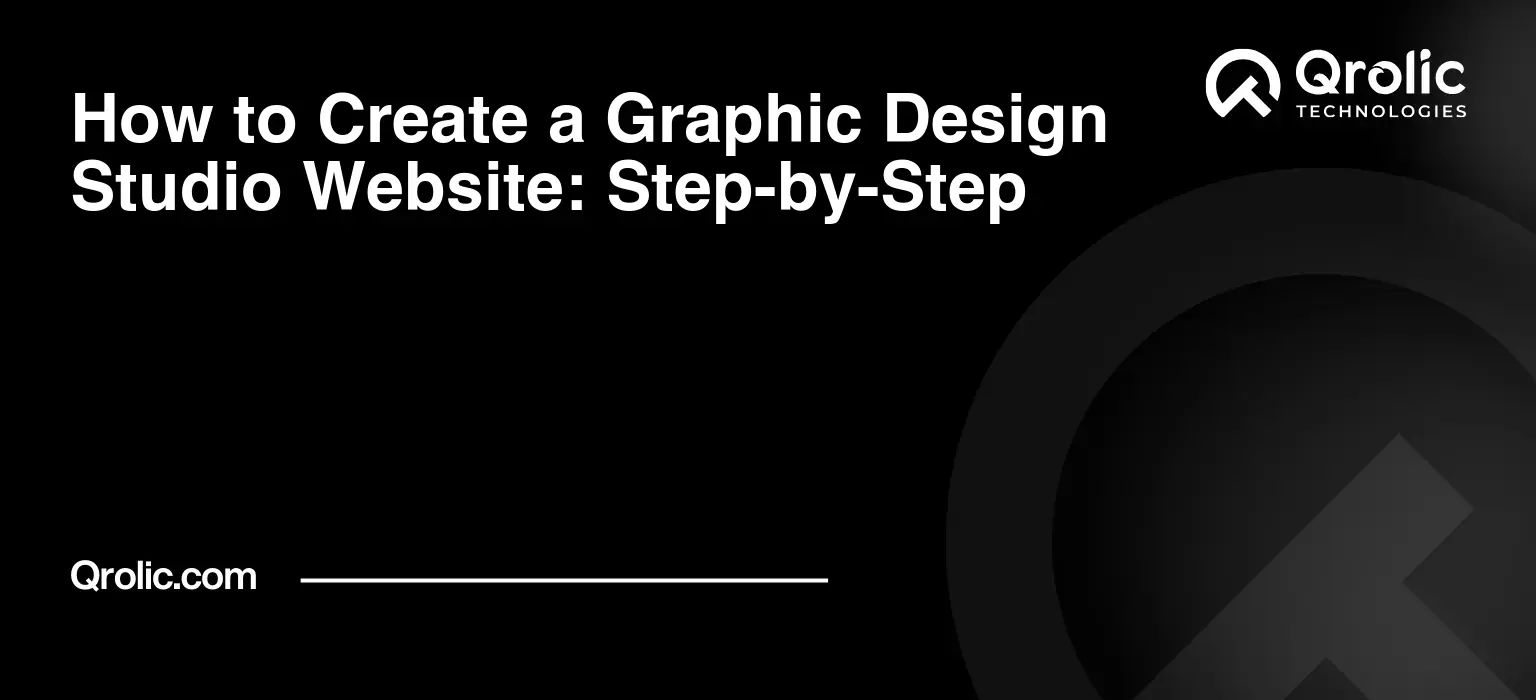Quick Summary:
- Your website is your studio’s vital digital storefront.
- Showcase your best work with clear, engaging messages.
- Ensure fast loading, easy navigation, and mobile design.
- Optimize your site for search engines and accessibility.
Table of Contents
- Why Your Graphic Design Studio Needs a Killer Website
- The Website as Your First Impression
- The Cost of a Bad Website: Lost Opportunities
- Essential Elements of Effective Graphic Design Studio Website Design
- 1. Stunning Portfolio: Show, Don’t Just Tell
- Key Considerations for Your Portfolio
- Examples of Compelling Portfolio Presentations
- 2. Clear and Concise Messaging: Tell Your Story
- Crafting Compelling Website Copy
- Essential Pages to Include
- 3. User-Friendly Navigation: Guiding the User Experience
- Best Practices for Website Navigation
- 4. Responsive Design: Adapting to Every Device
- Benefits of Responsive Web Design
- 5. Strong Call to Actions (CTAs): Guiding User Behavior
- Tips for Creating Effective CTAs
- 6. Brand Consistency: Reinforcing Your Identity
- Elements of Brand Consistency
- 7. Fast Loading Speed: Keeping Visitors Engaged
- Strategies for Improving Website Loading Speed
- 8. SEO Optimization: Attracting Organic Traffic
- Key SEO Strategies for Graphic Design Studios
- 9. Accessibility: Designing for Everyone
- Key Accessibility Considerations
- 10. Analytics and Tracking: Measuring Your Success
- Essential Metrics to Track
- Choosing the Right Platform for Your Graphic Design Studio Website
- 1. WordPress: The Versatile Option
- Advantages of WordPress
- Disadvantages of WordPress
- 2. Squarespace: The User-Friendly Choice
- Advantages of Squarespace
- Disadvantages of Squarespace
- 3. Wix: The Drag-and-Drop Solution
- Advantages of Wix
- Disadvantages of Wix
- 4. Custom-Coded Website: The Bespoke Approach
- Advantages of Custom-Coded Websites
- Disadvantages of Custom-Coded Websites
- The Importance of Creative Agency Web Development
- Showcasing Your Expertise Through Web Design
- Building Trust and Credibility
- Attracting the Right Clients
- Design Firm Website: Reflecting Professionalism and Innovation
- Emphasizing Your Firm’s Unique Selling Proposition
- Demonstrating Your Understanding of Design Principles
- Highlighting Your Team’s Expertise
- Qrolic Technologies: Your Partner in Creative Web Solutions
- Our Services
- Why Choose Qrolic Technologies?
- Conclusion: Investing in Your Digital Future
Why Your Graphic Design Studio Needs a Killer Website
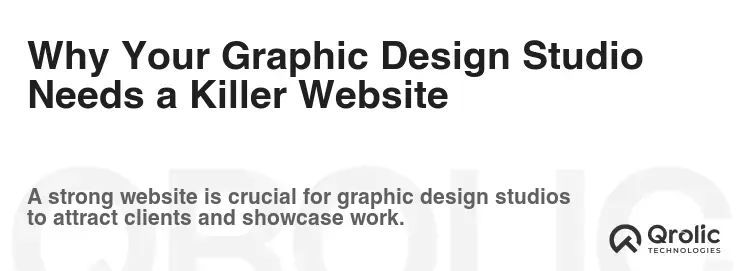
Your website is more than just an online brochure. It’s your digital storefront, your portfolio, your brand ambassador, and often, the first impression potential clients have of your graphic design studio. In a visual industry like graphic design, a compelling website isn’t just an asset; it’s a necessity.
The Website as Your First Impression
Think about it. Before a client even picks up the phone or sends an email, they’re likely scrutinizing your website. They’re assessing your design aesthetic, your technical capabilities, and whether your style aligns with their needs. A poorly designed website can immediately deter potential clients, regardless of how talented your team is.
- Trust and Credibility: A professional website instantly establishes credibility. It shows you’re serious about your business and invest in your online presence.
- Showcase Your Expertise: Your website is the ideal place to showcase your best work and highlight your unique design skills.
- Attract the Right Clients: A well-targeted website attracts clients who appreciate your style and are a good fit for your services.
- 24/7 Marketing: Your website works around the clock, marketing your services and generating leads even when you’re not actively working.
The Cost of a Bad Website: Lost Opportunities
Conversely, a poorly designed or outdated website can cost you valuable opportunities. Common pitfalls include:
- High Bounce Rate: Visitors leaving your site quickly due to poor navigation, slow loading times, or unappealing design.
- Low Conversion Rates: Difficulty in turning website visitors into actual clients.
- Negative Brand Perception: A website that doesn’t reflect your brand identity or design skills damages your reputation.
- Missed Lead Generation: Lack of clear call-to-actions and lead capture forms mean missed opportunities to connect with potential clients.
Essential Elements of Effective Graphic Design Studio Website Design
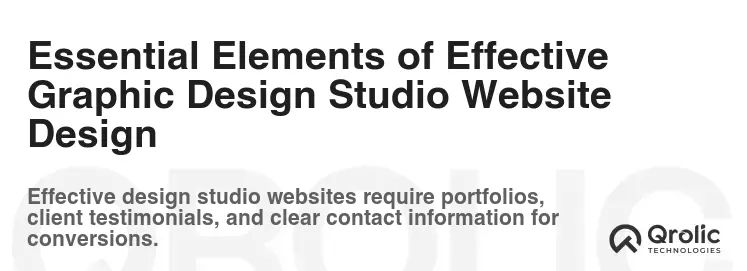
Creating an effective website for your graphic design studio requires a strategic approach that balances aesthetics, functionality, and user experience. Here’s a breakdown of the key elements:
1. Stunning Portfolio: Show, Don’t Just Tell
Your portfolio is the heart of your website. It’s where you showcase your best work and demonstrate your capabilities. It’s about far more than just slapping images on a page; it’s about crafting a visual narrative that highlights your creative process and the impact of your designs.
Key Considerations for Your Portfolio
- High-Quality Images and Videos: Use professional, high-resolution images and videos to showcase your work in the best possible light.
- Curated Selection: Don’t include everything you’ve ever designed. Choose your most compelling and relevant projects.
- Detailed Case Studies: Go beyond simply showing the finished product. Tell the story behind each project, including the client’s goals, your design process, and the results achieved.
- Categorization and Filtering: Make it easy for visitors to find the type of work they’re interested in (e.g., logo design, web design, branding).
- Mobile-Friendly Design: Ensure your portfolio looks great on all devices, from desktops to smartphones.
Examples of Compelling Portfolio Presentations
- Before-and-After Comparisons: Visually demonstrate the impact of your design work.
- Interactive Presentations: Use animations, videos, and other interactive elements to engage visitors.
- Client Testimonials: Include quotes from satisfied clients to add credibility to your portfolio.
- Process Documentation: Show sketches, mockups, and other behind-the-scenes materials to illustrate your creative process.
2. Clear and Concise Messaging: Tell Your Story
Your website’s content should clearly communicate your studio’s mission, values, and unique selling propositions. Potential clients need to quickly understand what you do, who you serve, and why they should choose you over the competition.
Crafting Compelling Website Copy
- Headline Focus: Use strong, attention-grabbing headlines that immediately convey your core value proposition.
- Benefit-Oriented Language: Focus on the benefits clients will receive from working with you, not just the features of your services.
- Target Audience Focus: Tailor your messaging to resonate with your ideal client.
- Brand Voice Consistency: Maintain a consistent brand voice throughout your website to create a cohesive brand experience.
- Concise and Readable Text: Use short paragraphs, bullet points, and visuals to break up large blocks of text and improve readability.
Essential Pages to Include
- Homepage: Introduce your studio, showcase your best work, and guide visitors to key sections of your website.
- About Us: Tell your studio’s story, highlight your team’s expertise, and share your values.
- Services: Clearly outline the services you offer and explain the benefits of each service.
- Portfolio: Showcase your best work with detailed case studies.
- Contact Us: Provide clear contact information and a simple contact form.
- Blog (Optional): Share valuable content related to design, marketing, and branding to attract potential clients and establish yourself as an industry expert.
3. User-Friendly Navigation: Guiding the User Experience
Intuitive navigation is crucial for ensuring visitors can easily find the information they need. A confusing or cumbersome navigation system can lead to frustration and a high bounce rate.
Best Practices for Website Navigation
- Simple and Clear Menu: Use a clear and concise menu with easily understandable labels.
- Logical Site Structure: Organize your website content in a logical and intuitive manner.
- Consistent Navigation: Maintain consistent navigation throughout your website.
- Search Functionality: Include a search bar to allow visitors to quickly find specific information.
- Breadcrumbs: Use breadcrumbs to help visitors understand their location within the website.
- Mobile-Friendly Navigation: Ensure your navigation is optimized for mobile devices.
4. Responsive Design: Adapting to Every Device
In today’s mobile-first world, it’s essential to have a responsive website that adapts seamlessly to different screen sizes and devices. A responsive design provides an optimal viewing experience for all users, regardless of whether they’re accessing your website on a desktop, tablet, or smartphone.
Benefits of Responsive Web Design
- Improved User Experience: Provides a consistent and enjoyable user experience across all devices.
- Increased Mobile Traffic: Caters to the growing number of users accessing the internet via mobile devices.
- Better SEO Rankings: Google favors responsive websites in its search results.
- Reduced Development Costs: Eliminates the need to develop separate mobile websites.
- Simplified Website Management: Easier to manage a single responsive website than multiple versions.
5. Strong Call to Actions (CTAs): Guiding User Behavior
Call to actions are prompts that encourage visitors to take specific actions on your website, such as contacting you for a consultation, downloading a brochure, or subscribing to your newsletter. Effective CTAs are essential for converting website visitors into leads and clients.
Tips for Creating Effective CTAs
- Use Action-Oriented Language: Use verbs that encourage action, such as “Get a Quote,” “Contact Us,” or “Download Now.”
- Create Visual Contrast: Make your CTAs stand out visually by using contrasting colors and ample white space.
- Place CTAs Strategically: Place CTAs in prominent locations on your website, such as the homepage, service pages, and blog posts.
- Test Different CTAs: Experiment with different wording, colors, and placement to see what works best.
- Make CTAs Mobile-Friendly: Ensure your CTAs are easily tappable on mobile devices.
6. Brand Consistency: Reinforcing Your Identity
Your website should be a visual extension of your brand identity. It should reflect your studio’s unique style, personality, and values. Consistency in branding helps to build brand recognition and create a cohesive brand experience.
Elements of Brand Consistency
- Logo Usage: Use your logo consistently throughout your website.
- Color Palette: Use a consistent color palette that reflects your brand’s personality.
- Typography: Use consistent fonts that are easy to read and align with your brand’s style.
- Imagery: Use consistent imagery that reflects your brand’s aesthetic.
- Tone of Voice: Maintain a consistent tone of voice in your website’s content.
7. Fast Loading Speed: Keeping Visitors Engaged
Website loading speed is a critical factor in user experience and SEO. Visitors are more likely to abandon a website that takes too long to load. Fast loading speeds improve user engagement, reduce bounce rates, and boost SEO rankings.
Strategies for Improving Website Loading Speed
- Optimize Images: Compress images to reduce file sizes without sacrificing quality.
- Enable Browser Caching: Allow browsers to cache website files to reduce loading times for returning visitors.
- Minimize HTTP Requests: Reduce the number of HTTP requests by combining files and using CSS sprites.
- Use a Content Delivery Network (CDN): Distribute your website’s content across multiple servers to improve loading speeds for users in different geographic locations.
- Choose a Fast Hosting Provider: Select a hosting provider with fast servers and reliable performance.
- Minify CSS and JavaScript: Remove unnecessary characters from your CSS and JavaScript files to reduce file sizes.
8. SEO Optimization: Attracting Organic Traffic
Search engine optimization (SEO) is the process of optimizing your website to rank higher in search engine results pages (SERPs). SEO is essential for attracting organic traffic to your website and generating leads.
Key SEO Strategies for Graphic Design Studios
- Keyword Research: Identify relevant keywords that potential clients are searching for.
- On-Page Optimization: Optimize your website’s content, title tags, and meta descriptions for your target keywords.
- Off-Page Optimization: Build high-quality backlinks from other websites to improve your website’s authority.
- Technical SEO: Ensure your website is crawlable and indexable by search engines.
- Local SEO: Optimize your website for local search to attract clients in your geographic area.
- Content Marketing: Create valuable and informative content that attracts potential clients and establishes you as an industry expert.
9. Accessibility: Designing for Everyone
Website accessibility is the practice of designing websites that are usable by people with disabilities. Accessible websites are not only more inclusive but also benefit all users by improving usability and SEO.
Key Accessibility Considerations
- Provide Alternative Text for Images: Use alt text to describe images for users who are visually impaired.
- Use Semantic HTML: Use semantic HTML elements to structure your website content in a meaningful way.
- Ensure Sufficient Color Contrast: Use sufficient color contrast between text and background to improve readability.
- Provide Keyboard Navigation: Ensure your website can be navigated using a keyboard alone.
- Use ARIA Attributes: Use ARIA attributes to provide additional information to assistive technologies.
- Test Your Website with Accessibility Tools: Use accessibility testing tools to identify and fix accessibility issues.
10. Analytics and Tracking: Measuring Your Success
Website analytics and tracking tools allow you to monitor your website’s performance, track user behavior, and identify areas for improvement. Data-driven insights are essential for optimizing your website and achieving your business goals.
Essential Metrics to Track
- Website Traffic: Track the number of visitors to your website.
- Bounce Rate: Monitor the percentage of visitors who leave your website after viewing only one page.
- Conversion Rate: Track the percentage of visitors who complete a desired action, such as filling out a contact form.
- Page Views: Track the number of times each page on your website is viewed.
- Time on Site: Monitor the average amount of time visitors spend on your website.
- Traffic Sources: Identify the sources of traffic to your website, such as organic search, social media, and referral links.
Choosing the Right Platform for Your Graphic Design Studio Website
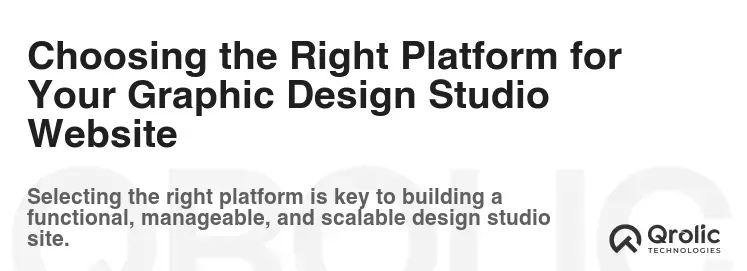
Selecting the right platform for your website is a crucial decision that can impact its functionality, scalability, and maintainability. Several popular platforms are well-suited for graphic design studios, each with its own strengths and weaknesses.
1. WordPress: The Versatile Option
WordPress is a popular content management system (CMS) known for its flexibility, ease of use, and extensive plugin ecosystem. It’s a great choice for graphic design studios that want a customizable website with robust content management capabilities.
Advantages of WordPress
- Highly Customizable: WordPress offers a wide range of themes and plugins that allow you to customize your website to your exact specifications.
- SEO-Friendly: WordPress is inherently SEO-friendly, making it easier to optimize your website for search engines.
- Easy to Use: WordPress is relatively easy to learn and use, even for non-technical users.
- Large Community: WordPress has a large and active community that provides support and resources.
- Cost-Effective: WordPress is open-source and free to use, although you’ll need to pay for hosting and a domain name.
Disadvantages of WordPress
- Security Vulnerabilities: WordPress websites can be vulnerable to security threats if not properly maintained.
- Plugin Conflicts: Plugins can sometimes conflict with each other, causing website issues.
- Maintenance Required: WordPress requires regular updates and maintenance to ensure optimal performance and security.
2. Squarespace: The User-Friendly Choice
Squarespace is a website builder known for its ease of use and beautiful templates. It’s a good option for graphic design studios that want a visually appealing website without the technical complexities of WordPress.
Advantages of Squarespace
- Easy to Use: Squarespace is incredibly easy to use, even for beginners.
- Beautiful Templates: Squarespace offers a wide range of professionally designed templates.
- All-in-One Platform: Squarespace includes hosting, domain registration, and other essential features.
- Built-in SEO Tools: Squarespace offers built-in SEO tools to help you optimize your website for search engines.
- Excellent Customer Support: Squarespace provides excellent customer support.
Disadvantages of Squarespace
- Limited Customization: Squarespace offers less customization options than WordPress.
- Higher Cost: Squarespace is more expensive than WordPress.
- Less Flexible: Squarespace is less flexible than WordPress in terms of functionality and features.
3. Wix: The Drag-and-Drop Solution
Wix is another popular website builder that offers a drag-and-drop interface for creating websites. It’s a good option for graphic design studios that want a simple and intuitive way to build a website.
Advantages of Wix
- Drag-and-Drop Interface: Wix’s drag-and-drop interface makes it easy to create and customize websites.
- Large Template Library: Wix offers a large library of templates to choose from.
- App Market: Wix offers an app market with a variety of apps to extend your website’s functionality.
- Free Plan Available: Wix offers a free plan, although it includes Wix branding and limited features.
Disadvantages of Wix
- Limited Customization: Wix offers less customization options than WordPress.
- SEO Limitations: Wix has some limitations in terms of SEO.
- Website Lock-In: Once you choose a template on Wix, you can’t switch to a different template.
4. Custom-Coded Website: The Bespoke Approach
For graphic design studios with specific needs and a strong technical team, a custom-coded website offers the ultimate flexibility and control. This approach allows you to create a website that is perfectly tailored to your brand and requirements.
Advantages of Custom-Coded Websites
- Ultimate Flexibility: Custom-coded websites offer complete control over design and functionality.
- Unique Design: You can create a truly unique website that reflects your brand identity.
- Optimal Performance: Custom-coded websites can be optimized for performance and speed.
- Scalability: Custom-coded websites can be easily scaled to accommodate future growth.
Disadvantages of Custom-Coded Websites
- High Cost: Custom-coded websites are the most expensive option.
- Technical Expertise Required: Custom-coded websites require significant technical expertise to develop and maintain.
- Long Development Time: Custom-coded websites can take longer to develop than other options.
The Importance of Creative Agency Web Development
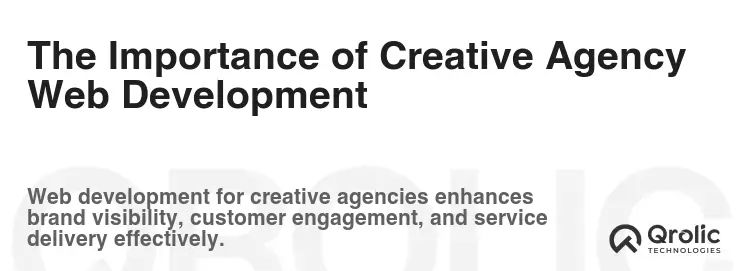
Creative agency web development goes beyond simply building a website; it’s about crafting a digital experience that embodies your brand’s values and showcases your creative prowess. Your website should be a testament to your design skills and a compelling representation of your agency’s capabilities.
Showcasing Your Expertise Through Web Design
Your website serves as a dynamic portfolio, highlighting your most successful projects and demonstrating your proficiency in various design disciplines. Potential clients should be able to easily navigate through your portfolio and understand the scope and impact of your work.
Building Trust and Credibility
A well-designed and functional website instills trust and credibility in potential clients. It shows that you’re professional, detail-oriented, and committed to delivering high-quality work.
Attracting the Right Clients
Your website acts as a filter, attracting clients who appreciate your design aesthetic and are a good fit for your services. By showcasing your unique style and approach, you can attract clients who align with your values and vision.
Design Firm Website: Reflecting Professionalism and Innovation

A design firm website needs to project an image of professionalism, innovation, and expertise. It should be a sophisticated and user-friendly platform that showcases your firm’s capabilities and attracts top-tier clients.
Emphasizing Your Firm’s Unique Selling Proposition
Your website should clearly communicate your firm’s unique selling proposition – what sets you apart from the competition. Highlight your areas of expertise, your design philosophy, and your track record of success.
Demonstrating Your Understanding of Design Principles
Your website should be a living embodiment of your firm’s understanding of design principles. It should be visually appealing, easy to navigate, and optimized for user experience.
Highlighting Your Team’s Expertise
Showcase your team’s expertise and experience by including detailed profiles and bios. Highlight their skills, certifications, and past accomplishments.
Qrolic Technologies: Your Partner in Creative Web Solutions

At Qrolic Technologies (https://qrolic.com/), we understand the unique needs of graphic design studios and creative agencies. We offer a range of web development and design services tailored to help you create a stunning online presence that reflects your brand and attracts clients.
Our Services
- Custom Website Design: We create custom websites that are tailored to your specific needs and reflect your brand identity.
- Responsive Web Development: We build responsive websites that look great on all devices.
- Portfolio Development: We create visually appealing and user-friendly portfolios that showcase your best work.
- SEO Optimization: We optimize your website for search engines to attract organic traffic and generate leads.
- Website Maintenance: We provide ongoing website maintenance and support to ensure your website is always up-to-date and secure.
Why Choose Qrolic Technologies?
- Experienced Team: Our team of experienced designers and developers has a proven track record of creating successful websites for graphic design studios and creative agencies.
- Client-Focused Approach: We work closely with our clients to understand their needs and goals and deliver solutions that exceed their expectations.
- Competitive Pricing: We offer competitive pricing without compromising on quality.
- Timely Delivery: We deliver projects on time and within budget.
Conclusion: Investing in Your Digital Future
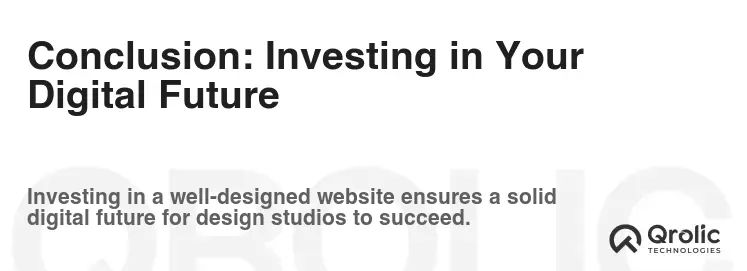
Your website is a critical investment in your graphic design studio’s future. By creating a visually appealing, user-friendly, and SEO-optimized website, you can attract new clients, showcase your expertise, and establish yourself as a leader in the design industry. Don’t underestimate the power of a well-crafted online presence – it can be the key to unlocking your studio’s full potential. The synergy of graphic design studio website design, strategic creative agency web development, and the professional touch of a design firm website is the cornerstone to digital success in the visual arts.


